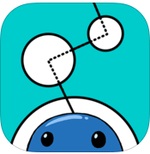More Details
Software
* Requires iOS 6.1 or later. Compatible with iPad.
Speech Quality
* Digitised children's voices (recorded children's voices)
* Boy / Girl voices
* US, UK and AUS voices
* Use the built-in recording studio to record new words when you enter/add new words to the vocabulary.
Access
* Direct access only
Vocabulary / Language
Symbol based - child friendly visuals are used
* Words are presented using a branching pathway system which is referred to as the Word Tree.
* It used word prediction, the child makes a word choice then branches with suggestions for the next word are presented automatically. Only five options are presented at a time.
* It includes a 'Category' page, where all the words are organised according to categories.
* Sentences may be saved in the 'Favourites' section.
* Words may be deleted, disabled or added.
* May add your own pictures, pictures/symbols can be customised.
Visual display - screen
The size of the screen depends on the size of the tablet screen being used.
May choose between:
* Large pictures with small words
* Small pictures with large words
Symbols / Pictures
* Pre-programmed words have accompanying picture symbols. Photos and images can be imported.
Batteries and Charging
* Check in relation to the tablet or phone device you are using. Regular charging may be needed to ensure the device will operate throughout the day.
Manual and Support
* A tutorial video for the user and carers is included in the app as a quick guide covering basic functions and features.
* An overview video is provided on this link http://www.spectronics.com.au/blog/new-technologies/aacorn-a-new-app-in-aac/
Considerations
Access
Consider the following:
* the user's pointing accuracy and motor control
* sensory needs (vision and hearing)
* layout (size and number of cells), as well as colours and contrast
* fatigue
* speed of access and operation
* Does the user need assistance from communication partner to access device (such as turn app/device on or off, navigate through pages etc..)?
* appropriate and safe mounting
* Can more than one access method be used at once (e.g: switching and eye-gaze)
Communication
* Is the user a pre-intentional or intentional communicator?
* Consider the person's current language skills (understanding and production of language) and their potential language development.
* Does the system match the person's current language skills and does it allow for later language development?
* Does the system require literacy skills?
* Does the system allow access to literacy and literacy development?
* How is language represented? (pictures, symbols, text etc..)
* Can the individual compose novel messages?
* Can vocabulary/messages provided be used across several contexts/situations?
Support
The involvement of a speech pathologist is recommended to ensure the system meets the user's current communication skills and allows for language development.
* Users and support people require training in the programming and the use of this app/device. Access to consistent therapy support is highly recommended.
* Programming performed on the computer is more efficient than on the device for people who are supporting its use.
* The operational features of the device can be locked out if required. This can prevent unintentional programming and changes to the device.
* This app/device contains pre-programmed page sets that are designed to be used as a base for users to customise as required. This can reduce the programming time required.




 subscribers
subscribers 


